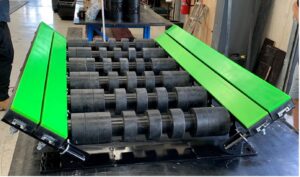What is the difference? Hydraulic Pumps and Motors on Conveyors, Crushers, and Screeners
Within conveying, crushing and screening equipment, hydraulic motors and pumps play a pivotal role in converting and transmitting energy for the purpose of making your machine run. While both hydraulic pumps and motors operate within the hydraulic circuit, their functions are inherently different. In this article, we will delve into the differences between hydraulic motors and pumps relevant to their application in crushing, screening, and conveying equipment.
Hydraulic Pumps: Powering the Material Flow
At the heart of hydraulic systems, pumps serve as the driving force behind fluid movement. Their primary function lies in converting mechanical energy into hydraulic energy, ensuring a steady flow of fluid throughout the system. In essence, hydraulic pumps are the initiators of the power transmission process. In material handling equipment specifically, hydraulic pumps play a central role in powering hydraulic cylinders and actuators. This enables the precise control and movement required for handling diverse loads in a range of applications.
There are various types of hydraulic pumps, with the most common being variable displacement pumps, gear pumps, vane pumps, and piston pumps. Each type has its unique characteristics, but they all share the common goal of generating the necessary pressure to facilitate the movement of hydraulic fluid. As fluid is drawn into the pump, mechanical action imparts energy to the fluid, pressurizing it and allowing it to move through the hydraulic system.
Variable Displacement Pumps converts mechanical energy (rotation or engine rotation) into hydraulic energy. However, some variable piston pumps will also perform opposite operations. That is, the conversion of hydraulic energy into mechanical energy (the function of a hydraulic motor). The flow and output pressure of the variable flow pump can be changed during operation. These pumps are commonly used to boost a wide variety of tools. But such bombs are more complex and expensive compared to others.
Gear pumps, characterised by simplicity and efficiency, use meshing gears to displace fluid. Vane pumps, on the other hand, employ sliding vanes in a rotating rotor to create the necessary pressure. Piston pumps, the more complex of the three, use reciprocating pistons to pressurize the hydraulic fluid. The choice of pump type depends on the specific requirements of the hydraulic system, considering factors such as flow rate, pressure, and efficiency.
Hydraulic Motors: Transforming Hydraulic Energy into Mechanical Power
In contrast to hydraulic pumps, hydraulic motors are devices designed to convert hydraulic energy back into mechanical power. They play a crucial role in various applications, but particularly on crushing, screening and conveying equipment. Essentially, hydraulic motors act as the end point in the hydraulic circuit, harnessing the power generated by the fluid and translating it into rotational or linear motion. In some crushing applications, hydraulic motors are employed to drive the crushing mechanism. The energy harnessed from pressurized fluid is translated into powerful mechanical force, facilitating the efficient and controlled breakdown of materials.
Similar to pumps, hydraulic motors come in various types, both fixed and variable displacement, with common variations being gear motors, vane motors, and piston motors. Each type has its specific advantages and is chosen based on the requirements of the application.
Gear motors, like their pump counterparts, use meshing gears to convert hydraulic energy into mechanical motion. Vane motors employ vanes within a rotor to generate motion, while piston motors utilise reciprocating pistons to achieve the same result. The selection of a particular motor type hinges on factors such as torque requirements, speed, and overall efficiency.
Efficiency Considerations: Enhancing Conveyor, Crusher, and Screener Operations
Efficiency is a critical factor in the operation of conveyors, crushers, and screeners. Both hydraulic pumps and motors play an important role in operating these systems, so understanding their characteristics is imperative for optimizing performance.
Conveyor systems benefit from hydraulic pumps with high volumetric efficiency, ensuring a consistent flow of hydraulic fluid for precise material handling. The mechanical efficiency of pumps, coupled with proper maintenance practices, contributes to the reliability and longevity of conveyor operations.
In crushers and screeners, the efficiency of hydraulic motors is paramount for achieving optimal performance. Mechanical efficiency, influenced by factors such as friction and leakage, plays a crucial role in ensuring that the hydraulic energy is effectively converted into the required mechanical force or motion. Regular maintenance practices and the selection of suitable hydraulic motor types based on application-specific requirements are integral to enhancing the efficiency of crushing and screening operations.
Conclusion
When dealing with hydraulic systems, much can influence the efficient operation of your equipment. When it comes time to replace your hydraulic pumps or motors, you will often find that newer versions can offer enhanced lifespan and performance to older models, often with lower maintenance overheads. To speak more about your hydraulic requirements, speak to ACBG about your specific needs. We can often recommend a range of pumps and motors for your needs. Our approach is to ensure the Australian industry can access high quality components at affordable prices. All our pumps and motors have been tested in demanding environments, particularly mining and quarry operations.






